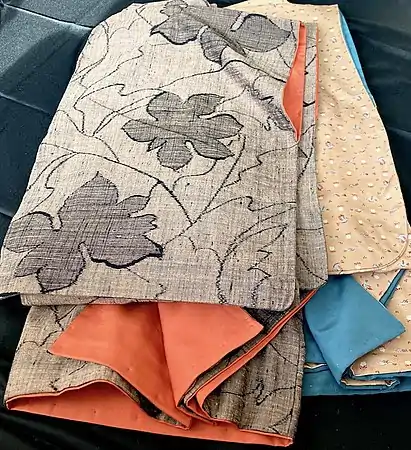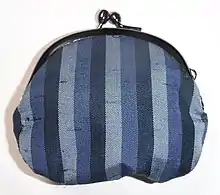Tsumugi (紬) is a traditional slub-woven silk fabric from Japan. It is a tabby weave material woven from yarn produced using silk noil, short-staple silk fibre (as opposed to material produced using longer, filament silk fibres). The short silk fibres are degummed[1] and, traditionally, the yarns are hand-joined to form a continuous length before weaving,[2] a technique also used for cheaper bast fibres. Yarns are joined by twisting the ends to be joined in the same direction, then twisting both ends, bundled together, in the other direction, to make a two-ply yarn at the overlap.[3] It might alternately be loosely handspun, with few twists per unit length.[4] Because of this structure, tsumugi is rough-surfaced, soft and drapey, softening further with age.
Between 1910 and 1925 (late Taishō to Shōwa era), it became common to spin as well as weave silk noil by machine (see meisen for the technological developments that made this possible).[5][6] This machine-spun meisen cloth largely displaced tsumugi as one of the cheapest silk fabrics. Prices dropped drastically, and silk materials and clothing was suddenly within the budget of most Japanese;[6] stores also began to sell off-the-peg, ready-to-wear kimono at about this time.[7]
Originally, tsumugi was homemade from domestic or wild-gathered silkworm cocoons that had been broken by hatching[8] or were irregularly formed.[4] Unlike the long-fiber silk, such cloth was permitted to peasants.[9] Traditionally a peasant cloth, handmade tsumugi is very labour-intensive to produce, and has become expensive over time, valued as a luxury folk-craft.
Recognized regional varieties
Tsumugi was originally a homespun textile, produced using silk fibre deemed unusable for the production of finer fabrics, and many regional variations existed. Some of these regional variations still exist today and are recognized as meibutsu, famous products of their place of origin.
| Name | Kanji | Traditional sites | Notes | Example image | |
|---|---|---|---|---|---|
| Amiito tsumugi | Shiga Prefecture | Recycled weft threads respun and rewoven to make obi. | |||
| Gujo tsumugi | 郡上島紬 | Hachiman, Gifu | |||
| Honba oshima tsumugi | 本場大島紬 | Amami, Kagoshima | |||
| Iida tsumugi | 飯田島紬 | Iida, Nagano | |||
| Kumejima-tsumugi | 久米島紬 | Kumejima, Okinawa | |||
| Murayama-oshima tsumugi | 村山大島紬 | Musashimurayama, Tokyo | |||
| Oitama tsumugi | 置賜紬 | Oitama regions of production:
|
Oitama tsumugi is a collective term for six different varieties of tsumugi made in the Yamagata region, including:
|
||
| Ojiya tsumugi | 小千谷島紬 | Ojiya, Niigata | |||
| Shinshu tsumugi | 信州紬 | Nagano Prefecture | |||
| Shiozawa tsumugi | 塩沢島紬 | Shiozawa, Niigata | |||
| Tosa men tsumugi | Kagami, Kōchi (Kami) | ||||
| Ueda tsumugi | 上田島紬 | Ueda, Nagano | Ueda tsumugi is always striped and is sometimes referred to as ueda jima (jima meaning "stripes"). | ||
| Ushikubi tsumugi | 牛首紬 | Hakusan, Ishikawa | |||
| Yūki-tsumugi | 結城紬 | Yūki, Ibaraki |
Yūki-tsumugi kimono are often made with thread spun by hand. It can take up to three months to make enough thread for one kimono by an experienced weaver.[10] |
||
| Ōshima Tsumugi | 大島紬 | Amami Ōshima |
Ōshima Tsumugi is dyed with mud and dye from the bark of Sharinbai Tree. This creates a black color.[11] |
See also
References
- ↑ "Variety of Nishijin textile". Nishijin Textile Industry Association. 17 September 2020. Retrieved 17 July 2021.
- ↑ "Ojiya tsumugi silk". KOGEI JAPAN.
- ↑ Dusenbury, Mary (1992). "A WISTERIA GRAIN BAG and other tree bast fiber textiles of Japan". Textile Society of America Symposium Proceedings. Retrieved 12 June 2021.
- 1 2 "UNESCO - Intangible Heritage Home". ich.unesco.org.
A yarn [sic][for tsumugi] should be spun by hand out of silk floss. A hard twist yarn cannot be used
- ↑ "Khalili Collections | Japanese Kimono | Kimono for a Woman". Khalili Collections.
- 1 2 "Komon". Kimono mochi: kimono collection.
The lowly komon kimono is the workhorse of the kimono wardrobe, worn for trips to town, to friends houses, in any situation which is outside of the home but informal. Despite their name, which means 'small design', komon can have large or small imagery, and the repeat can be staggered widely. painted, closely stencilled, woven, Printed, striped, spotted, shibori, silk, jinken, modern polyester—if it's a repetitive design, short-sleeved, and without kamon, then it's a komon. [this quote given as the title in the metadata]
- ↑ "Furisode". Kimono Mochi: private kimono collection photographs and text. Retrieved 31 July 2021.
- ↑ Dalby, Liza Crihfield (2001). Kimono : fashioning culture. London: Vintage. p. 156. ISBN 9780099428992.
the cloth that peasants wove for themselves from the broken filaments of wild cocoons after the moths had emerged, or from the leftovers of the cultivated crop that had been spoiled or broken by hatching the seed moths that would lay the eggs for the next season's crop of silkworms.
- ↑ Ruth M. Shaver (1966). Kabuki Costume. Tuttle Publishing.
- ↑ https://kogeijapan.com/locale/en_US/yukitsumugi/
- ↑ http://www.tumugi.co.jp/english/index.html




